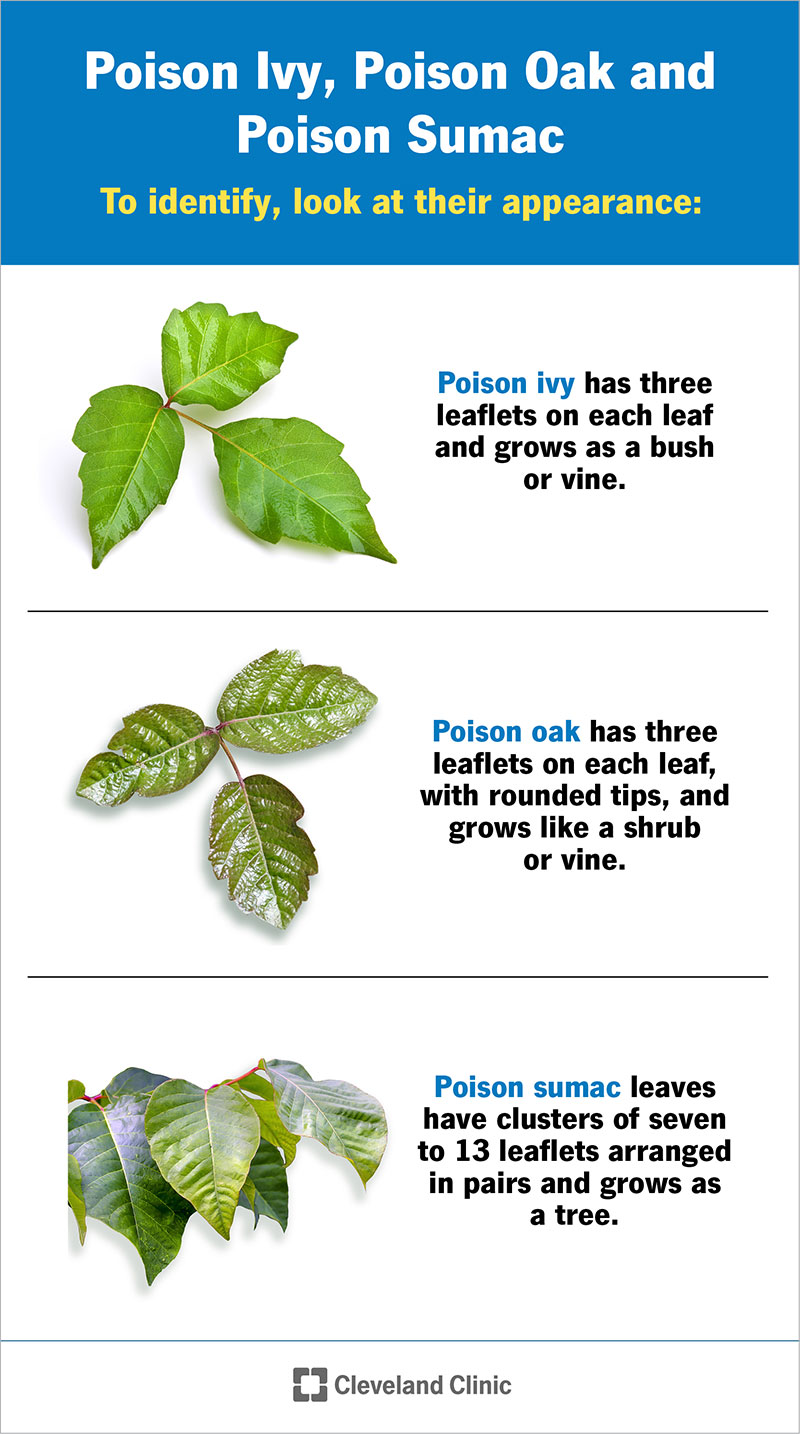Poison ivy, poison oak and poison sumac are all very common poisonous plants. Touching any of these plants can result in an irritating, itchy skin rash. These plants produce an oil called urushiol that almost everyone is allergic to. Rashes from these plants usually go away within two weeks. In the meantime, treatment includes OTC medications.
Advertisement
Cleveland Clinic is a non-profit academic medical center. Advertising on our site helps support our mission. We do not endorse non-Cleveland Clinic products or services. Policy

Poison ivy is a common poisonous plant that causes an itchy skin rash. Other rash-inducing poisonous plants include poison oak and poison sumac. These plants produce an oily sap that contains urushiol (pronounced yer-OO-shee-all), which causes an irritating, itchy allergic reaction. When you touch the poisonous plant or an object that’s been in contact with the plant’s oil, you develop an itchy rash on that area of your skin. This rash is a form of allergic contact dermatitis.
Advertisement
Cleveland Clinic is a non-profit academic medical center. Advertising on our site helps support our mission. We do not endorse non-Cleveland Clinic products or services. Policy
Up to 90% of people who come into contact with poison ivy oil develop an itchy rash. You don’t have to be exposed to much: 50 micrograms (μg) of urushiol — an amount smaller than a grain of salt — is enough to cause a reaction. You can become susceptible to a poison ivy rash at any time in your life, even if you never reacted to it in the past.
Nearly everyone who touches urushiol gets a poison ivy rash. You’re more likely to come into contact with a poisonous plant if you’re a:
Poisonous plants grow everywhere in the United States except Hawaii and Alaska. Each type has a distinctive appearance.
If you’re wondering how to identify poison ivy, look at its leaves. Each leaf of the poison ivy plant has three leaflets. A popular saying is, “leaves of three, let them be.” Poison ivy leaves turn reddish in the spring, green in the summer and yellow, orange or red in the fall.
Poison ivy grows as a shrub or a vine. A poison ivy vine is hairy and ropelike. Eastern U.S. poison ivy typically grows as a vine. Western U.S. poison ivy normally grows low to the ground as a shrub. Poison ivy does not have thorns. A poison ivy shrub may have white berries.
Advertisement
Poison oak leaves have three leaflets like poison ivy but with rounded tips. The undersides of the leaves are fuzzy and lighter in color than the top.
Poison oak typically grows as a shrub in the Eastern and Southern U.S. The shrub sometimes has white or yellow berries. Poison oak grows more commonly as a vine in the Western U.S.
Each leaf of a poison sumac plant has clusters of seven to 13 smooth leaflets arranged in pairs. Poison sumac thrives in wet, swampy regions in the Northeast, Midwest and parts of the southeast U.S.
A full-grown poison sumac tree can get up to 20 feet tall. This tall tree has drooping clusters of pale yellow, cream-colored or green berries. Nonpoisonous sumacs have red, upright berries. Contact with nonpoisonous sumacs won’t cause an allergic rash.
Poison ivy, poison oak and poison sumac produce urushiol oil. Almost everyone is allergic to it. The oil causes an allergic reaction when it touches your skin. The itchy rash that develops is a type of allergic contact dermatitis.
Poison ivy symptoms almost always include:
Depending on your skin’s sensitivity, a rash may develop within a few hours or a few days after initial contact with urushiol oil. The intensity of the itching can vary, and some people may develop one or two small rashes while others develop rashes all over their bodies.
A poison ivy rash on your skin usually looks like red, itchy bumps. Some people can develop black spots or streaks on their skin instead of the telltale red rash (this is rare). If you have black-spot poison-ivy dermatitis, you’ll have very little or no swelling or redness.
Poison oak rash and poison sumac rash look the same as poison ivy rash. This is because urushiol oil causes the same allergic reaction no matter which poisonous plant you touch.
No matter how long it takes for a rash to appear, it usually comes in stages and peaks within one to 14 days of exposure. However, symptoms can develop as long as 21 days after initial exposure to urushiol oil for those who’ve never been in contact with it before.
For most people, the stages of poison ivy rash include:
It may look like your rash is spreading, but you’re actually developing new rashes on areas of skin that came into contact with urushiol oil. You might’ve touched a plant in some areas and not even realized it — for example, a backpack strap brushed against poisonous plants and touched your bare shoulder. Some rashes take longer to develop. The extent of the rash depends on your skin sensitivity and how much oil you touched.
Advertisement
You can’t get a poison ivy rash by touching another person’s rash. But you could develop a rash if you touch the oil on another person’s body or clothes. You can also come in contact with the oil by touching your pet’s fur or a contaminated item like a gardening tool or camping gear. The fluid from blisters doesn’t contain urushiol oil and isn’t contagious.
Some situations increase your risk of problems if you’re exposed to poison ivy, poison oak or poison sumac. These factors include:
A healthcare provider will look at the rash, assess your symptoms and ask questions to determine if you could’ve encountered a poisonous plant. Other allergens and irritants besides poisonous plants can cause contact dermatitis or an itchy rash. If you haven’t been outdoors or in contact with plants, your provider will rule out other skin conditions or causes.
Advertisement
You can’t get rid of poison ivy in one day, but for the fastest relief, you should take the following steps:
Rashes from poisonous plants usually go away on their own within a week or two. In the meantime, poison ivy treatment includes over-the-counter (OTC) medications that can relieve the itchy rash:
Advertisement
Your healthcare provider may prescribe a poison ivy rash treatment if it becomes more severe or forms on the mucous membranes of your eyes, nose, mouth or genitals. They may recommend an oral steroid such as prednisone.
Your healthcare provider may also prescribe treatment for a secondary infection if this develops.
Home remedies for poison ivy include:
Poison ivy rashes cause mild (but annoying) symptoms that go away within a week or two. Rarely, a skin rash can last for longer than a month. Try not to scratch. Scratching can break open skin and cause an infection.
Poison oak and poison sumac rashes should go away within one to two weeks.
The best way to avoid developing this itchy rash is by learning what poisonous plants look like so you can avoid them.
If you think you’ve come in contact with a poisonous plant, you can:
Visit your healthcare provider if you have a poisonous plant rash and you experience:
If you have a poisonous plant rash, you may want to ask your healthcare provider:
Poison hemlock is another poisonous plant that grows throughout the U.S. It differs from poison ivy, poison sumac and poison oak because you typically won’t get a rash if you touch it. Usually, poison hemlock is only poisonous if you ingest it. The plant is more toxic than poison ivy — it can be fatal if ingested.
It’s hard not to scratch an itchy poison ivy rash. Fortunately, most rashes clear up with minimal treatment within a week. Ask your healthcare provider for suggestions to stop the itch. And remember, don’t scratch! You might temporarily feel better, but scratching can introduce bacteria into the skin and cause an infection.
Need care fast? Cleveland Clinic’s Express Care and Urgent Care locations treat everything from sprains to sinus infections — no appointment needed.

Last reviewed on 05/05/2023.
Learn more about the Health Library and our editorial process.